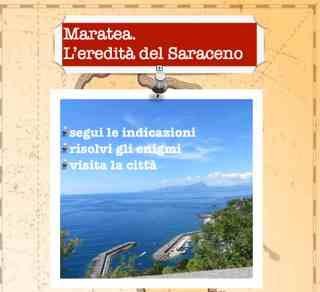The medieval village of MARATEA
Il sito www.maratea.info è aggiornato dai volontari di ALTRITURISMI.it
FAI UNA DONAZIONE
- Per essere aggiornato sulle attività di AltriTurismi ETS -> Iscriviti alla newsletter
Alleys and alleys ...

The "BORGO" or the Historic Center of Maratea has the characteristic medieval structure, with old houses decorated with loggia and doorways, stacked together and divided by narrow alleys and angulations.
From Piazza Buraglia, via Cavour, you reach the obelisk of Addolorata (1788) by the unknown Lucano sculptor commissioned by the citizen Gerardo Laurelli, whose back is the church of the Addolorata of 1620.
CACCIA AL TESORO
Un nuovo e divertente modo di esplorare la città
UN' AVVINCENTE CACCIA AL TESORO
che unisce nel divertimento tutta la famiglia
MARATEA. L'EREDITA' DEL SARACENO
" il Borgo " : Historic Center of Maratea
Il sito www.maratea.info è aggiornato dai volontari di ALTRITURISMI.it
FAI UNA DONAZIONE
- Per essere aggiornato sulle attività di AltriTurismi ETS -> Iscriviti alla newsletter
Across the street Pietra del Pesce, crosses the seventeenth-century Palazzo Picone, formerly the Town Hall and crossing a large palace with a small central fountain, you will come to the belvedere of Pietra del Sole, from which you can enjoy a magnificent view over the whole valley and coast.
From the Grand Palace on Via Gafaro you reach the rock on which the palace of Lieto was erected, built at the beginning of the 18th century to host the first hospital in Maratea in 1734; A few meters wide the piazza of S. Maria Maggiore with the church Mother and, right on the right, the eighteenth-century palazzo of Orlando.
The church of S. Maria Maggiore was erected in the 13th and 14th centuries, and has undergone numerous subsequent extensions.
The square base of the bell tower is 1434, while the second octagonal order is sixteenth century; In the seventeenth century the portal was executed and the adjoining defensive tower was absorbed.
Il sito www.maratea.info è aggiornato dai volontari di ALTRITURISMI.it
FAI UNA DONAZIONE
- Per essere aggiornato sulle attività di AltriTurismi ETS -> Iscriviti alla newsletter
The original nucleus of the Borgo
On the facade in front of the square are two marble bas-reliefs dating back to the middle of the 15th century.
Inside there are various artistic works of a certain value, including the inlaid chest of the '400 and a statue depicting the Madonna degli Angeli of the' 600. [Learn more]
Starting from the piazzale of S. Maria Maggiore, you reach the oldest nucleus of the village through a stairway leading to via Santicelli and then via Capocasale and then extending to the Castle.
Of this original nucleus, to see the 17th-century Calderano house, distinguished by a valuable portal; From this corner a promenade rises up to the oldest church of Maratea, the church of S. Vito, erected with the first houses of the village between XI and XII century.
It features remarkable frescoes of 1300, including a Madonna with Child and a fresco of 1500 with the effigy of S. Rocco and S. Biagio.
On the side of the church stands a beautiful bell tower, the effect of a nineteenth-century reconstruction.
TO BE CONTINUED IN: PIAZZA BURAGLIA ->




